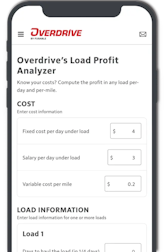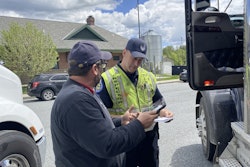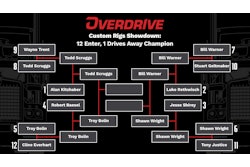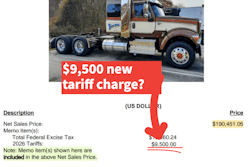The White House on Thursday issued the first Unified Agenda of Regulatory and Deregulatory Actions under the second Trump administration, marking the first regulatory update since last fall.
- This new "Spring 2025" agenda details every federal department's updated timelines for rulemaking on the horizon -- including those from the Department of Transportation.
- DOT's Federal Motor Carrier Safety Administration has a total of 41 rulemakings on the agenda with action expected on the majority either by the end of 2025, or by the end of May 2026.
- The National Highway Traffic Safety Administration also has a couple of trucking-related rules in the making, and the Department of Labor is planning a move on independent contractor classification.
See below for some of the more high-profile rules and when agencies plan to take action on them. Find information for the dozens of other rules and proposals in the works via this link.
Broker transparency
It's been more than five years gone since petitions went up the ladder to FMCSA from the Owner-Operator Independent Drivers Association and Small Business in Transportation Coalition to amend FMCSA’s rules for brokered freight transparency. The agency, according to the agenda, is planning to publish a second notice of proposed rulemaking (NPRM) by the end of May 2026.
The first NPRM on broker transparency was published last November and proposed a “regulatory obligation” for brokers to share transaction records upon request from a motor carrier or shipper. It’s unclear how the second NPRM might be different.
The Transportation Intermediaries Association, representing brokers, has been vocal in its opposition to the NPRM and has repeatedly called the transparency regs already on the books in 49 CFR 371.3 an "unnecessary, outdated, burdensome regulation.” Owner-operator interests and other truckers have expressed support for change by big margins, as evidenced by Overdrive surveying and reporting over the last couple of years.

[Related: What's happened to broker transparency]
Automatic emergency braking systems
A second NPRM, issued jointly by FMCSA and NHTSA, is intended to require and/or standardize equipment performance for automatic emergency braking on heavy trucks and motor carrier maintenance requirements for vehicles equipped with such technology. The rulemaking is the result of a statutory mandate by Congress in the Infrastructure Investment and Jobs Act.
The agencies said the NPRM “proposes test procedures for measuring performance of these systems.” The agencies plan to publish the second NPRM by the end of the year.
[Related: Are FMCSA and NHTSA skirting Congressional directive with AEB proposal?]
Safety fitness procedures
Following an advance notice of proposed rulemaking (ANPRM) in 2023, FMCSA plans to publish an NPRM by the end of May 2026 to propose ways to more effectively identify unfit motor carriers and to remove them from the nation's roadways. The rule would also include a review of the list of Federal Motor Carrier Safety Regulations (FMCSRs) that the agency uses in its safety fitness rating methodology, the agency said.
This is FMCSA’s second attempt in the last decade to revamp its safety rating methodology.
Currently, FMCSA uses an analysis of existing motor carrier data and data collected during a compliance review, either on-site or remotely through a review of records. The agency calculates a vehicle out-of-service rate, reviews crash involvement, and conducts an in-depth examination of a motor carrier’s compliance with the acute and critical regulations and hazmat regulations.
[Related: Fit or unfit? FMCSA keying in on problems with 'Conditional' safety rating limbo]
Side underride guards
NHTSA signaled that it’s still working through comments on a 2023 ANPRM about potential requirements for side underride guards on trailers and semitrailers to mitigate underride crashes into the side of those vehicles. The agency has set a January 2026 timeline for “analyzing comments,” but did not indicate if or when an NPRM would follow.
[Related: Side underride guard mandate: Rail disaster waiting to happen?]
Independent contractor classification
While not a DOT rulemaking, the Department of Labor has indicated that it plans to rescind its 2024 final rule for determining whether a worker is an employee or an independent contractor under the Fair Labor Standards Act (FLSA).
DOL noted that the rule “is the subject of five separate legal challenges,” adding that it plans to rescind the rule “and is considering how it will proceed with respect to independent contractor classification under the FLSA.”
That 2024 rule rolled back a DOL rule from the first Trump administration, which included a test to determine if a worker was independent or an employee that relied on five factors, but put greater emphasis on two “core factors” -- the nature and degree of the worker’s control over the work and the worker’s opportunity for profit or loss. Other “non-core factors” included the amount of skill required for the work; the degree of permanence of the working relationship between the worker and the potential employer; and whether the work is part of an integrated unit of production.
The Biden-era rule returned to a “totality-of-the-circumstances analysis” for classification determinations that considered the worker’s “economic reality” through six factors weighted equally.
The Owner-Operator Independent Drivers Association said it generally supports the Trump administration’s latest efforts on worker classification, but noted that it did not fully support the 2021 Trump rule because a provision of the rule would have allowed fleets where owner-operators were leased to require so-called “safety” equipment to be on their trucks, such as speed limiters.
“We support the Trump Administration’s goal of protecting independent contractors provided they reject the American Trucking Associations’ backdoor attempt to mandate dangerous speed limiter devices on truckers,” said OOIDA President Todd Spencer. “The Department of Labor should follow the lead of the Department of Transportation in determining that speed limiter devices are detrimental to the safety of all motorists. We encourage the Department of Labor to listen to actual independent contractors in the trucking industry, not the corporate megacarriers seeking to exploit them.”
ATA, meanwhile, offered its full support of the DOL’s intention to rescind the 2024 contractor rule.
“By moving to rescind the Biden-era rule on independent contractors, the Trump Administration is rejecting a reckless, job-killing scheme finalized by Acting Labor Secretary Julie Su,” said ATA President & CEO Chris Spear. “That rule would have wiped out choice, crushed opportunity, and sidelined hundreds of thousands of truckers who fuel our economy. We look forward to continuing our participation in the process to repeal this rule, which will be a victory for truckers, for the economy, and for common sense.”
[Related: Are leased owner-operators really independent contractors for labor-law purposes?]









